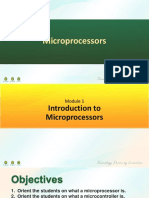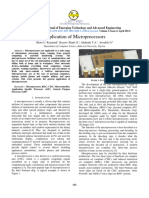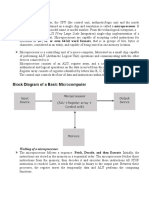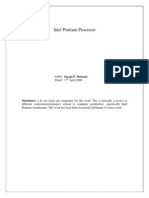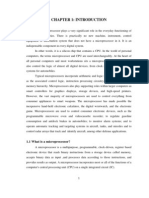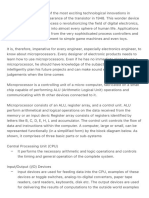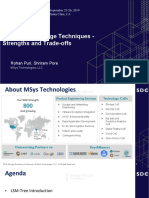0 ratings0% found this document useful (0 votes)
11 viewsMicro Continuation
Micro Continuation
Uploaded by
JANELLA ROSE BITANG1) The document discusses the history of microprocessors from the 1st to 5th generations. It describes the evolution from 4-bit processors in the 1970s to today's 64-bit processors.
2) It also outlines some key characteristics of microprocessors, including clock speed, instruction set, word size, and components like the CPU, buses, and memory.
3) Basic terms related to microprocessors are defined, such as instruction set, the different types of buses, and instructions per cycle.
Copyright:
© All Rights Reserved
Available Formats
Download as PDF, TXT or read online from Scribd
Micro Continuation
Micro Continuation
Uploaded by
JANELLA ROSE BITANG0 ratings0% found this document useful (0 votes)
11 views3 pages1) The document discusses the history of microprocessors from the 1st to 5th generations. It describes the evolution from 4-bit processors in the 1970s to today's 64-bit processors.
2) It also outlines some key characteristics of microprocessors, including clock speed, instruction set, word size, and components like the CPU, buses, and memory.
3) Basic terms related to microprocessors are defined, such as instruction set, the different types of buses, and instructions per cycle.
Copyright
© © All Rights Reserved
Available Formats
PDF, TXT or read online from Scribd
Share this document
Did you find this document useful?
Is this content inappropriate?
1) The document discusses the history of microprocessors from the 1st to 5th generations. It describes the evolution from 4-bit processors in the 1970s to today's 64-bit processors.
2) It also outlines some key characteristics of microprocessors, including clock speed, instruction set, word size, and components like the CPU, buses, and memory.
3) Basic terms related to microprocessors are defined, such as instruction set, the different types of buses, and instructions per cycle.
Copyright:
© All Rights Reserved
Available Formats
Download as PDF, TXT or read online from Scribd
Download as pdf or txt
0 ratings0% found this document useful (0 votes)
11 views3 pagesMicro Continuation
Micro Continuation
Uploaded by
JANELLA ROSE BITANG1) The document discusses the history of microprocessors from the 1st to 5th generations. It describes the evolution from 4-bit processors in the 1970s to today's 64-bit processors.
2) It also outlines some key characteristics of microprocessors, including clock speed, instruction set, word size, and components like the CPU, buses, and memory.
3) Basic terms related to microprocessors are defined, such as instruction set, the different types of buses, and instructions per cycle.
Copyright:
© All Rights Reserved
Available Formats
Download as PDF, TXT or read online from Scribd
Download as pdf or txt
You are on page 1of 3
4-bit Microprocessor Generations of Microprocessors:
First generation (4-bit Microprocessors)
From 1971 to 1972 the era of the first
generation came which brought microprocessors
like INTEL 4004 Rockwell international PPS-4
INTEL 8008 etc.
Second generation (8 - bit Microprocessor)
The second generation marked the
8-bit and 16-bit Microprocessor development of 8-bit microprocessors from 1973
to 1978. Processors like INTEL 8085 Motorola
6800 and 6801 etc came into existence
Third-generation (16-bit Microprocessor)
The third generation brought forward
the 16-bit processors like INTEL
8086/80186/80286 Motorola 68000 68010 etc.
From 1979 to 1980 this generation used the
HMOS technology.
Fourth generation (32 - bit Microprocessors)
Intel Pentium Microprocessor Series The fourth generation came into
existence from 1981 to 1995. The 32-bit
processors using HMOS fabrication came into
existence. INTEL 80386 and Motorola 68020 are
some of the popular processors of this
generation.
Fifth generation (64-bit Microprocessors)
From 1995 till now we are in the fifth
generation. 64-bit processors like PENTIUM,
Celeron, dual, quad, and octa-core processors
came into existence
HISTORY OF MICROPROCESSOR Microprocessors Characteristics
Microprocessors are multipurpose
devices that can be designed for generic or
specialized functions. The microprocessors of
laptops and smartphones are general purpose
whereas ones designed for graphical processing or
machine vision are specialized ones. There are
some characteristics that are common to all
microprocessors. These are the most important
defining characteristics of a microprocessor −
Clock speed, Instruction set and Word size.
(a) Clock Speed
Every microprocessor has an internal
clock that regulates the speed at which
it executes instructions and also
synchronizes it with other
components. The speed at which the
microprocessor executes instructions
is called clock speed.
Clock speeds are measured in MHz or
GHz where 1 MHz means 1 million
cycles per second whereas 1 GHz
equals to 1 billion cycles per second.
Here cycle refers to single electric
signal cycle.
Currently microprocessors have clock
speed in the range of 3 GHz, which is
maximum that current technology can ~ALU (Arithmetic Logic Unit), ALU − It has
attain. Speeds more than this generate necessary circuits to perform arithmetic, logical,
enough heat to damage the chip itself. memory, register and program sequencing
To overcome this, manufacturers are operations,
using multiple processors working in
parallel on a chip. ~Register − It holds intermediate results
obtained during program processing. Registers
(b) Word Size are used for holding such results rather than
Number of bits that can be processed RAM because accessing registers is almost 10
by a processor in a single instruction is times faster than accessing RAM.
called its word size.
Word size determines the amount of
RAM that can be accessed at one go BUS
and total number of pins on the
microprocessor. Total number of input Connection lines used to connect the internal
and output pins in turn determines the parts of the microprocessor chip is called bus.
architecture of the microprocessor. There are three types of buses in a
First commercial microprocessor Intel microprocessor –
4004 was a 4-bit processor. It had 4
input pins and 4 output pins. Number Data Bus − Lines that carry data to and
of output pins is always equal to the from memory are called data bus. It is a
number of input pins. Currently most bidirectional bus with width equal to word
microprocessors use 32-bit or 64-bit length of the microprocessor.
architecture. Address Bus − It is a unidirectional
(c) Instruction Set responsible for carrying address of a
A command given to a digital machine to memory location or I/O port from CPU to
perform an operation on a piece of data memory or I/O port.
is called an instruction. Basic set of Control Bus − Lines that carry control
machine level instructions that a signals like clock signals, interrupt signal or
microprocessor is designed to execute is ready signal are called control bus. They
called its instruction set. are bidirectional. Signal that denotes that a
These instructions do carry out these device is ready for processing is called
types of operations – ready signal. Signal that indicates to a
Data transfer device to interrupt its process is called an
Arithmetic operations interrupt signal.
Logical operations
Control flow
Input/output and machine control MEMORY
Memory Microprocessor has two types of
Microprocessor Components memory:
>>Compared to the first microprocessors, RAM − Random Access Memory is
today’s processors are very small but still they volatile memory that gets erased when
have these basic parts right from the first model power is switched off. All data and
− CPU, Bus and Memory instructions are stored in RAM.
ROM − Read Only Memory is non-
volatile memory whose data remains intact
even after power is switched off.
Microprocessor can read from it any time it
wants but cannot write to it. It is
preprogrammed with most essential data
like booting sequence by the manufacturer.
CPU
>> CPU is fabricated as a very large scale
integrated circuit (VLSI) and has these parts:
~Instruction register − It holds the
instruction to be executed,
~Decoder − It decodes (converts to machine
level language) the instruction and sends to the
SUMMARY OF THE BASIC TERMS USED IN MICROPROCESSOR
Here is a list of some basic terms used in microprocessor:
Instruction Set - The group of commands that the microprocessor can understand is called
Instruction set. It is an interface between hardware and software.
Bus - Set of conductors intended to transmit data, address or control information to different elements
in a microprocessor. A microprocessor will have three types of buses, i.e., data bus, address bus, and
control bus.
IPC (Instructions Per Cycle) - It is a measure of how many instructions a CPU is capable of
executing in a single clock.
Clock Speed - It is the number of operations per second the processor can perform. It can be
expressed in megahertz (MHz) or gigahertz (GHz). It is also called the Clock Rate.
Bandwidth - The number of bits processed in a single instruction is called Bandwidth.
Word Length - The number of bits the processor can process at a time is called the word length of the
processor. 8-bit Microprocessor may process 8 -bit data at a time. The range of word length is from 4
bits to 64 bits depending upon the type of the microcomputer.
Data Types - The microprocessor supports multiple data type formats like binary, ASCII, signed and
unsigned numbers
You might also like
- Detailed Lesson Plan in Computer Systems Servicing For Grade 12 - KYLE FABIANDocument7 pagesDetailed Lesson Plan in Computer Systems Servicing For Grade 12 - KYLE FABIANKyle Joseph Fabian100% (5)
- Heidenhain TNC 131 - 135 ManualDocument83 pagesHeidenhain TNC 131 - 135 Manualjalexpt50% (2)
- 12f28948 De0a 47ec Bdf1 545ac4742729 Microprocessor and MicrocontrollerDocument89 pages12f28948 De0a 47ec Bdf1 545ac4742729 Microprocessor and MicrocontrollerManthanNo ratings yet
- Microprocessor and AssemblyDocument85 pagesMicroprocessor and AssemblyMilan BhandariNo ratings yet
- Microprocessor: A Short Guide To Written Exam MicroprocessorDocument16 pagesMicroprocessor: A Short Guide To Written Exam MicroprocessorSakib Muhaimin100% (1)
- Microprocessor ComponentsDocument2 pagesMicroprocessor ComponentsBryan Yaranon100% (1)
- Ch1Document29 pagesCh1Sagar DhamiNo ratings yet
- Intro 2Document32 pagesIntro 2narutomonkey68No ratings yet
- 2 NdmicroDocument20 pages2 Ndmicroaklilu YebuzeyeNo ratings yet
- Lecture 2Document22 pagesLecture 2kjkhushijain1401No ratings yet
- 01 Introduction To MicroprocessorDocument57 pages01 Introduction To MicroprocessorMuhammad JunaidNo ratings yet
- Introduction To Micro ProcessorsDocument9 pagesIntroduction To Micro ProcessorsJapheth NgugiNo ratings yet
- Chapter 1-v3 ARM - 3Document35 pagesChapter 1-v3 ARM - 3Weehao SiowNo ratings yet
- Module 01 Introduction To MicroprocessorsDocument26 pagesModule 01 Introduction To MicroprocessorsJASPER PAYAPAYANo ratings yet
- SUMSEM2023-24 BECE204L TH VL2023240700453 2024-05-25 Reference-Material-IDocument32 pagesSUMSEM2023-24 BECE204L TH VL2023240700453 2024-05-25 Reference-Material-Iarbaz4923No ratings yet
- What Is A MicroprocessorDocument25 pagesWhat Is A MicroprocessorFiromsa DineNo ratings yet
- MicroprocessorDocument108 pagesMicroprocessordicijNo ratings yet
- MicroPROCESSOR Week 1Document66 pagesMicroPROCESSOR Week 1Aira Nichole TiczonNo ratings yet
- What Is Microprocessor - Evolution, Types, Applications and WorkingDocument12 pagesWhat Is Microprocessor - Evolution, Types, Applications and WorkingSayed Abdul HadiNo ratings yet
- Microprocessor: Prepared by Engr. Rynefel ElopreDocument16 pagesMicroprocessor: Prepared by Engr. Rynefel ElopreRynefel ElopreNo ratings yet
- Microprossor Chapter 1Document49 pagesMicroprossor Chapter 1bayabayechaNo ratings yet
- Application of MicroprocessorsDocument6 pagesApplication of MicroprocessorsAli Hussain Ali MahmoudNo ratings yet
- A Study On Computer Processors and Their GenerationsDocument3 pagesA Study On Computer Processors and Their Generationslady jazzmineNo ratings yet
- Microprocessors Evolutionintroductionto8085 150803070442 Lva1 App6892Document63 pagesMicroprocessors Evolutionintroductionto8085 150803070442 Lva1 App6892nomanrumi2917No ratings yet
- MP and MALP Notes 8085Document27 pagesMP and MALP Notes 8085Tripti Kumari YadavNo ratings yet
- Chapter 1 Introduction - 2024Document37 pagesChapter 1 Introduction - 2024tesfayebbNo ratings yet
- Cte 241 MicroprocessorsDocument13 pagesCte 241 MicroprocessorsIorlaha SamuelNo ratings yet
- CS3691 Embedded Systems and IoT Lecture Notes 2-4-128Document125 pagesCS3691 Embedded Systems and IoT Lecture Notes 2-4-128shylaNo ratings yet
- WINSEM2023-24 BECE204L TH VL2023240505477 2024-01-05 Reference-Material-IDocument22 pagesWINSEM2023-24 BECE204L TH VL2023240505477 2024-01-05 Reference-Material-Idevanshshukla577No ratings yet
- Microprocessors and Interfacing Devices - Unit-1Document42 pagesMicroprocessors and Interfacing Devices - Unit-1Sanket ChavanNo ratings yet
- Microprocessors and Interfacing Devices PDFDocument160 pagesMicroprocessors and Interfacing Devices PDFNimish BansalNo ratings yet
- CH 1Document12 pagesCH 1ghanayakamalaalamNo ratings yet
- 1 Chapter-1Document45 pages1 Chapter-1Eyouale TensaeNo ratings yet
- Lecture 1 Introduction To MicroprocessorsDocument16 pagesLecture 1 Introduction To MicroprocessorsSaif UddinNo ratings yet
- Chapter 1 IntroductionDocument34 pagesChapter 1 Introductionmitul.patelNo ratings yet
- W2 Types of Microprocessor Module 2Document5 pagesW2 Types of Microprocessor Module 2Aaron BasNo ratings yet
- Unit 1 Intro To MicroprocessorDocument20 pagesUnit 1 Intro To Microprocessoraayushadhikari9172No ratings yet
- Microprocessor Systems and VLSI Devices - Part 1Document17 pagesMicroprocessor Systems and VLSI Devices - Part 1TharinduNo ratings yet
- MICROPROCESSORSDocument10 pagesMICROPROCESSORSKELVIN MUTHININo ratings yet
- Micro ElectronicsDocument31 pagesMicro ElectronicsmwahspiceNo ratings yet
- 5.1 - Microcontroller and Microprocessor ArchitectureDocument35 pages5.1 - Microcontroller and Microprocessor ArchitectureMUHAMMAD HARIZ AZFAR AZAHARINo ratings yet
- Lecture 1Document34 pagesLecture 1MuhammadSaeedTahirNo ratings yet
- Microcontroller and Microprocessor Part IDocument72 pagesMicrocontroller and Microprocessor Part I2021308464No ratings yet
- The Intel 4004 Microprocessor, Which Was Introduced in 1971 Was The First MicroprocessorDocument21 pagesThe Intel 4004 Microprocessor, Which Was Introduced in 1971 Was The First MicroprocessorPraise PhillipsNo ratings yet
- EEAC 110 Learning Material 1Document11 pagesEEAC 110 Learning Material 1Krizel Joyce C. NullarNo ratings yet
- 8051Document90 pages8051Owolabi Oyeyemi RafiuNo ratings yet
- Microprocessors Prelim Q1Document3 pagesMicroprocessors Prelim Q1xianchao801No ratings yet
- Embedded SystemsDocument27 pagesEmbedded Systemsnavneet100% (1)
- Microprocessor ConceptsDocument3 pagesMicroprocessor ConceptswilyoukismeNo ratings yet
- Processor ClassificationDocument4 pagesProcessor ClassificationFredrick MugoNo ratings yet
- 7 BSc CS Microprocessor.inddDocument96 pages7 BSc CS Microprocessor.inddRWITHWIKLAL M T KNo ratings yet
- Microprocessor: Evolution & Insights of 8086Document43 pagesMicroprocessor: Evolution & Insights of 8086நட்ராஜ் நாதன்No ratings yet
- Microprocessor and ApplicationsDocument4 pagesMicroprocessor and ApplicationsNabaraj KhatiwadaNo ratings yet
- MicroprocessorDocument16 pagesMicroprocessorReenaNo ratings yet
- Mohan Ty Intel Survey 2000Document14 pagesMohan Ty Intel Survey 2000shahbunafNo ratings yet
- Chapter 1: Introduction: 1.1 What Is A Microprocessor?Document69 pagesChapter 1: Introduction: 1.1 What Is A Microprocessor?Niran SafarNo ratings yet
- Presented by Priya SAI M. SC Physics 1 SEM Guided by Rojan Joy SirDocument16 pagesPresented by Priya SAI M. SC Physics 1 SEM Guided by Rojan Joy SirSourabhYadavNo ratings yet
- A Microprocessor Is One of The Most Exciting Technological InnovationsDocument16 pagesA Microprocessor Is One of The Most Exciting Technological InnovationsTrixieNo ratings yet
- Microprocessor, Microcontrollers & Embedded System CSE 3523 ShifatDocument18 pagesMicroprocessor, Microcontrollers & Embedded System CSE 3523 ShifatprantostartNo ratings yet
- DLD&MP Unit-IV & V NotesDocument29 pagesDLD&MP Unit-IV & V NotesproanimewatcherrNo ratings yet
- Digital Electronics, Computer Architecture and Microprocessor Design PrinciplesFrom EverandDigital Electronics, Computer Architecture and Microprocessor Design PrinciplesNo ratings yet
- Physical Computing: Exploring Computer Vision in Physical ComputingFrom EverandPhysical Computing: Exploring Computer Vision in Physical ComputingNo ratings yet
- New CS WorkBook 2023 Hardware OnlyDocument21 pagesNew CS WorkBook 2023 Hardware OnlyAtifa Omer100% (1)
- Chapter 8: Power Management: OutlineDocument33 pagesChapter 8: Power Management: OutlineDurga Sasi dharNo ratings yet
- 1.1 Hardware and SoftwareDocument12 pages1.1 Hardware and SoftwareZahir SherNo ratings yet
- MotherboardsDocument29 pagesMotherboardslynnlahlohNo ratings yet
- HDDMajDocument51 pagesHDDMajIlijana JovančevićNo ratings yet
- Internal Memory - Cache Memory and Primary/main Memory External Memory - Magnetic Disk / Optical Disk EtcDocument6 pagesInternal Memory - Cache Memory and Primary/main Memory External Memory - Magnetic Disk / Optical Disk EtcSoundarya SvsNo ratings yet
- E3062 ProgrammingDocument207 pagesE3062 ProgrammingAdron Lim100% (1)
- DL-502-503 Broch 7010 2062 Reva-V3Document2 pagesDL-502-503 Broch 7010 2062 Reva-V3Marcos RomeroNo ratings yet
- Cse Toc NotesDocument3 pagesCse Toc NotesVijaya LakshmiNo ratings yet
- Chapter 1: An Overview of Computers and Programming LanguagesDocument49 pagesChapter 1: An Overview of Computers and Programming LanguagesYhung MillarNo ratings yet
- VSP - G1x00 - F1500 - v80-06-02 - Hardware Guide - MK-92RD8007-19Document187 pagesVSP - G1x00 - F1500 - v80-06-02 - Hardware Guide - MK-92RD8007-19ice7907903No ratings yet
- #Splitvg #RecreatevgDocument19 pages#Splitvg #RecreatevgabhidhingraNo ratings yet
- Unit Unit: Installation and Configuration of Operating SystemDocument52 pagesUnit Unit: Installation and Configuration of Operating SystemH123 Thawal GauravNo ratings yet
- ks4ws Netstorage Guide enDocument87 pagesks4ws Netstorage Guide enhappy girlNo ratings yet
- BIST Algorithm For Embedded-DRAM CoresDocument4 pagesBIST Algorithm For Embedded-DRAM CoresespskcNo ratings yet
- Operating System Notes For MCADocument83 pagesOperating System Notes For MCAyamnimeshram2004No ratings yet
- First YearDocument21 pagesFirst YearMUHAMMAD SALEEM RAZANo ratings yet
- Puri Rohan Pore Shriram LSM-based Storage Techniques Strengths and Trade-Offs PDFDocument44 pagesPuri Rohan Pore Shriram LSM-based Storage Techniques Strengths and Trade-Offs PDFsanthoshbr1975No ratings yet
- Introduction To Embedded Systems: Prabal Dutta & Edward A. LeeDocument35 pagesIntroduction To Embedded Systems: Prabal Dutta & Edward A. Leeهداية مسلمةNo ratings yet
- Operating System Exercises - Chapter 2 SolDocument4 pagesOperating System Exercises - Chapter 2 Solevilanubhav75% (4)
- Offline NT Password & Registry Editor, WalkthroughDocument10 pagesOffline NT Password & Registry Editor, WalkthroughbilbilaNo ratings yet
- Dell EMC Avamar Data Migration Enabler User GuideDocument100 pagesDell EMC Avamar Data Migration Enabler User Guidemanish.puri.gcpNo ratings yet
- Siemens Simadyn D Brochure PDFDocument36 pagesSiemens Simadyn D Brochure PDFvishadkapadiaNo ratings yet
- Commissioner General Instruction On Electronic Billing Machine CertificationDocument32 pagesCommissioner General Instruction On Electronic Billing Machine CertificationVenkata Sriramachandra Santosh KumarNo ratings yet
- (AISSOC) - Management Information SystemDocument14 pages(AISSOC) - Management Information SystemRENZ ALFRED ASTRERONo ratings yet
- Ict 9Document5 pagesIct 9OMG WOWNo ratings yet
- Computer Organization and Architecture (AT70.01)Document49 pagesComputer Organization and Architecture (AT70.01)Shanthi MuthusamyNo ratings yet
- Computer Notes Section 1.1Document13 pagesComputer Notes Section 1.1MichaelNo ratings yet













